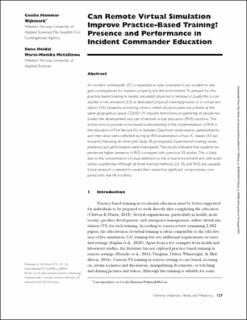Can Remote Virtual Simulation Improve Practice-Based Training? Presence and Performance in Incident Commander Education
Peer reviewed, Journal article
Published version
Permanent lenke
https://hdl.handle.net/11250/3028882Utgivelsesdato
2022Metadata
Vis full innførselSamlinger
Originalversjon
Wijkmark, C. H., Heldal, I., & Metallinou, M.-M. (2019). Can remote virtual simulation improve practice-based training? Presence and performance in incident commander education. PRESENCE: Virtual and Augmented Reality, 28, 127-152. 10.1162/pres_a_00346Sammendrag
An incident commander (IC) is expected to take command in any incident to mitigate consequences for humans, property, and the environment. To prepare for this, practice-based training in realistic simulated situations is necessary. Usually this is conducted in live simulation (LS) at dedicated (physical) training grounds or in virtual simulation (VS) situations at training centers, where all participants are present at the same geographical space. COVID-19-induced restrictions on gathering of people motivated the development and use of remote virtual simulation (RVS) solutions. This article aims to provide an increased understanding of the implementation of RVS in the education of Fire Service ICs in Sweden. Data from observations, questionnaires, and interviews were collected during an RVS examination of two IC classes (43 participants) following an initial pilot study (8 participants). Experienced training values, presence, and performance were investigated. The results indicated that students experienced higher presence in RVS, compared with previous VS studies. This is likely due to the concentration of visual attention to the virtual environment and well-acted verbal counterplay. Although all three training methods (LS, VS, and RVS) are valuable, future research is needed to reveal their respective significant compromises, compared with real-life incidents.

